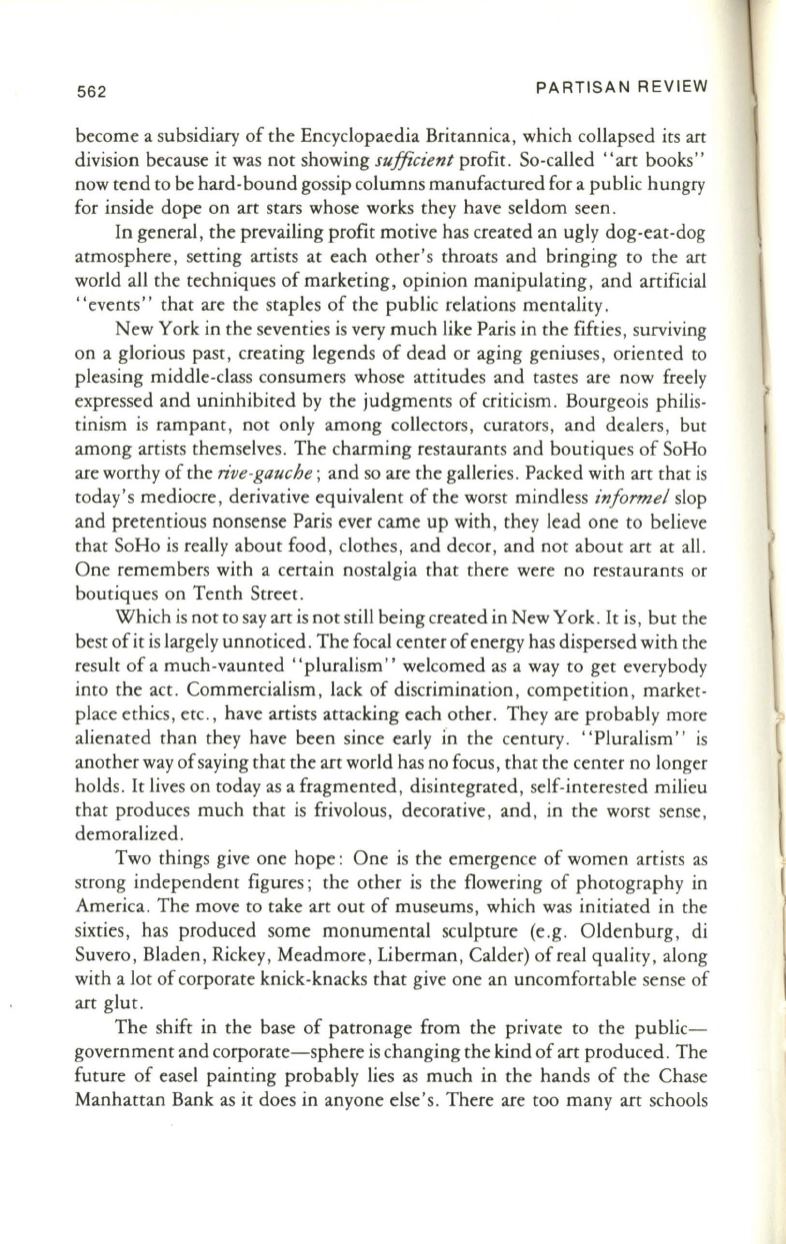
562
PARTISAN REVIEW
become a subsidiary of the Encyclopaedia Britannica, which collapsed its
art
division because it was not showing
sufficient
profit . So-called " art books "
now tend to be hard-bound gossip columns manufactured for a public hungry
for inside dope on art stars whose works they have seldom seen .
In general , the prevailing profit motive has created an ugly dog-eat-dog
atmosphere , setting artists at each other's throats and bringing to the art
world all the techniques of marketing, opinion manipulating , and artificial
" events " that are the staples of the public relations mentality .
New York in the seventies is very much like Paris in the fifties, surviving
on a glorious past, creating legends of dead or aging geniuses , oriented to
pleasing middle-class consumers whose attitudes and tastes are now freely
expressed and uninhibited by the judgments of criticism . Bourgeois philis–
tinism is rampant, not only among collectors, curators, and dealers , but
among artists themselves . The charming restaurants and boutiques of SoHo
are worthy of the
rive-gauche;
and so are the galleries . Packed with art that is
today 's mediocre, derivative equivalent of the worst mindless
in/armel
slop
and pretentious nonsense Paris ever came up with , they lead one to believe
that SoHo is really about food, clothes, and decor, and not about art at all .
One remembers with a certain nostalgia that there were no restaurants or
boutiques on Tenth Street.
Which is not to say art is not still being created in New York . It is , but the
best of it is largely unnoticed . The focal center ofenergy has dispersed with the
result of a much-vaunted "pluralism" welcomed as a way to get everybody
into the act . Commercialism , lack of discrimination , competition , market–
place ethics, etc., have artists attacking each other. They are probably more
alienated than they have been since early In the century . " Pluralism" is
another way ofsaying that the art world has no focus, that the center no longer
holds. It lives on today as a fragmented , disintegrated , self-interested milieu
that produces much that is frivolous, decorative , and , in the worst sense ,
demoralized.
Two things give one hope: One is the emergence of women artists as
strong independent figures ; the other is the flowering of phorography in
America . The move
to
take art out of museums, which was initiated in the
sixties, has produced some monumental sculpture (e .g. Oldenburg , di
Suvero , Bladen , Rickey , Meadmore, Liberman, Calder) of real quality , along
with a lot of corporate knick-knacks that give one an uncomfortable sense of
art glut.
The shift in the base of patronage from the private to the public–
government and corporate-sphere is changing the kind of art produced . The
future of easel painting probably lies as much in the hands of the Chase
Manhattan Bank as it does in anyone else 's. There are too many art schools


